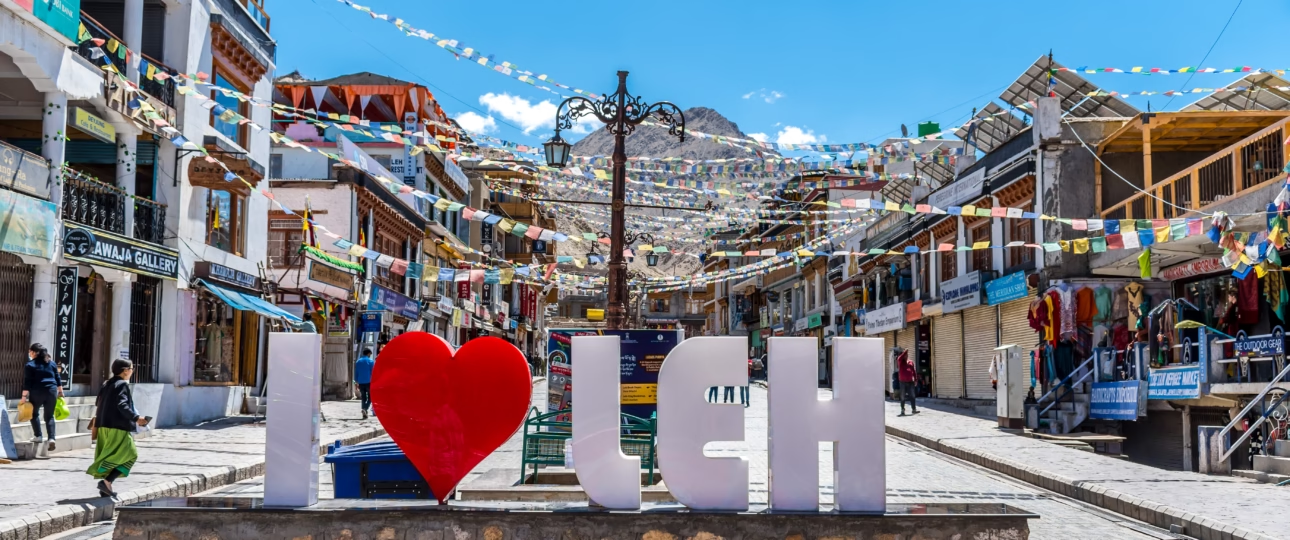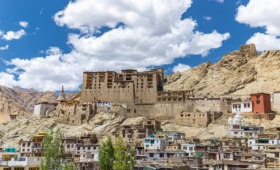In 10-day Leh Ladakh Itinerary, you can visit the beautiful Pangong Lake, ancient monasteries at Hemis and Lamayuru, Nubra Valley along the old Silk Road, and great views of the snow-capped landscape.
Whether you fly to Leh for a short visit or include it in a longer trip through North India, your time in Ladakh will be unforgettable. Get ready for some long drives, and you will be amazed by the stunning landscapes and rich history that Ladakh has to offer.
When to Visit Ladakh
The best time to visit Ladakh is from mid-May to the end of September. This is when the weather is warm during the day and mild at night. The roads and trekking routes are also clear of snow in the summer, making it easier to reach different places.
How to Get Around Ladakh
Traveling by road is one of the best parts of any trip to Ladakh. The scenery offers stunning views that you’ll want to enjoy, even if some drives are long, bumpy, and winding.
You have a few options for getting around Ladakh and visiting various sights during this 10-day Leh Ladakh Itinerary trip. Your choice will depend on your budget and comfort level. I suggest using taxis for day trips and joining a shared group tour for the trips to Pangong Lake and Nubra Valley, unless you prefer to arrange a private tour.
Here’s a brief overview of your transport options:
- Public bus: Public transport is limited in Ladakh. If you plan to use local buses, you will need a lot of time and patience to visit all the best places. This option is not ideal if you only have 10 days.
- Taxi: Taxis are great for day trips in Leh. You can easily book taxis to visit Thiksey, Lamayuru, Hemis, Alchi, and more. For example, a popular day trip to Shey, Thiksey, and Hemis costs about 3900 INR. You should budget more for trips to Alchi and Lamayuru.
- Group tours: Joining group tours to Pangong Lake and Nubra Valley is a popular choice. During the high season from June to August, you will find groups leaving every day in shared taxis for 3-4 days. You can arrange this after arriving in Leh.
- Private tours: If you prefer to plan your entire trip to Ladakh in advance, We recommend booking a 10-day tour with a local company in Leh. They can set up taxis for day trips and provide a private car for trips to Pangong Lake and Nubra Valley.
For more information about these options, see the Complete Travel Guide to Ladakh.
10-Day Leh Ladakh Itinerary Overview
Day 1: Fly from Delhi to Leh.
Day 2: Adjust to the high altitude in Leh.
Day 3: Continue to acclimatize and explore Leh town.
Day 4: Take a day trip to Thiksey, Hemis, and Shey.
Day 5: Enjoy a day trip to Lamayuru and Alchi.
Day 6: Drive to Nubra Valley via Khardung La.
Day 7: Visit Pangong Lake and stay overnight.
Day 8: Return to Leh.
Day 9: Relax in Leh. Optional visit to Stok village.
Day 10: Fly back to Delhi.
Detailed 10 Day Ladakh Itinerary
Here’s how to spend 10 days in Ladakh, especially if you’re ready for some long drives and want to see a lot in a short time.
Day 1: Delhi to Leh
If you’re taking a quick 10-day trip to Ladakh, you will likely fly into Leh from Delhi. Many flights go from Delhi to Leh every day, mostly in the morning. This flight is often called one of the most beautiful in the world.
Airlines like Air India, Vistara, SpiceJet, and IndiGo run these flights. The flight takes about 1.5 hours and costs between 3000 INR and 12000 INR one way.
If you prefer to travel to Leh by public transport, you can also come from Manali or Srinagar, depending on your time and plans.
Once you arrive in Leh, head straight to your accommodation and rest for the day. The high altitude can make you feel unwell after about 2-3 hours, so it’s best to relax and drink plenty of water in the afternoon to help your body adjust.
Day 2: Acclimatise in Leh
Your first full day in Leh is for getting used to the altitude. You might wake up with a headache, shortness of breath, or feel tired. These are common when you arrive in Ladakh from Delhi.
To avoid getting sick and to adjust to the high altitude, rest as much as you can. Drink plenty of water and eat small, regular meals to keep your energy up.
Try to avoid doing too much on this day, unless you are coming from a place that is about 2000 meters high or more. If you feel up to it, you can walk into town for dinner.
Day 3: Acclimatise and Explore Leh Town
You will still need to adjust to the altitude for at least 48 hours after you arrive, so avoid overdoing it on day three. However, you will likely want to explore this beautiful mountain town. Here’s how to spend your day:
Morning: Enjoy breakfast at your guesthouse or at a cafe in the main market area. Some great options are Bodhi Terrace, Bon Appetit, or Asian Corner Restaurant.
Mid-morning: Visit the Central Asian Museum, then walk around the main market.
Lunch: Try the local Tibetan food at Tibetan Kitchen.
Afternoon: Explore Leh Palace and Tsemo Maitreya Temple.
Dinner: Consider dining at Chopsticks or Wanderers Terrace.
Day 4: Day Trip to Thiksey and Hemis Monasteries (plus Shey Palace if you have time)
Today is a great opportunity to explore some of the best monasteries and villages in the Ladakh area. You can take a bus to Thiksey Monastery and Shey Palace if you are patient, or hire a taxi or motorbike for the day to visit all three sites, including Shey Palace.
Hemis Monastery is one of the most important monasteries in the region. It was established in the 17th century and is located in a gorge within Hemis National Park. The main highlight of the complex is its museum, which houses important Buddhist relics and artefacts from India.
Thiksey Monastery is an impressive structure built like the Potala Palace in Lhasa. The temples at the top have beautiful Buddhist statues and monuments. You will also enjoy a fantastic view over the valley.
Day 5: Day Trip to Lamayuru and Alchi
Today, you’ll take a longer day trip to Lamayuru. The drive is one of the most beautiful in the area. You’ll drive through stunning landscapes, small villages, and see tall mountain peaks and rivers on both sides. After about three hours, you’ll reach Lamayuru, the oldest monastery in Ladakh.
The monastery is built on several levels across the rocky land and is an impressive sight. If you visit during the midday puja, you can sit with the monks and listen to their chanting prayers.
On your way back to Leh, stop at Alchi to see the unique 1,000-year-old Buddhist murals and shrines, which are off the main road. There are also some great local restaurants, and Alchi Kitchen is a standout if you plan to have lunch there.
Day 6: Road trip to Nubra Valley via Khardung La
Today, you’ll drive from Leh to Nubra Valley. First, visit Khardung La pass, which is at 5,360 meters. It used to be the highest road in the world, making it a great spot for photos. Afterward, you’ll go down to Nubra Valley, passing the Shyok River and the Karakoram Mountains.
Nubra Valley is beautiful and was part of the old Silk Road route between Pakistan and Tibet. You can visit Diskit Monastery and see the giant Maitreya Buddha statue, which offers great views of the eastern Karakoram Mountains.
Next, head to the village of Hunder to see the double-humped Bactrian camels wandering in the sand dunes surrounded by mountains.
You can stay overnight in either Hunder or Diskit.
Day 7: Drive to Pangong Lake and Spend the Night
Without coming back to Leh drive from Diskit or Hunder through the valley to reach Pangong Lake. This drive can be long and challenging, but enjoy the stunning mountain views along the way.
Pangong Lake is one of the highest saltwater lakes in the world, located at 4,250 meters. It is a sacred site for Buddhists, with about two-thirds of the lake lying in Tibet. The lake’s bright blue color stands out against the dry, desert-like mountains, creating a unique sight that attracts many visitors each year.
Spend the night along the shores of the lake. The most popular spot is Spangmik, which has glamping tents and small hotels. However, some find Spangmik too commercialized and prefer to continue to Man or even Merak. These nearby villages offer more relaxed tents and homestays.
Day 8: Return to Leh
On this final long driving day, you will return to Leh via Changla Pass, which is at 5,360 meters. After all that driving, you may want to relax in the afternoon or enjoy good food at one of the cafes in Leh.
Day 9: Relax in Leh (Optional visit to Stok village)
On your last day in Leh, you might not want to drive anywhere. You can stay in Leh and do some shopping in the main market area. If you want to see more, visit Stok village, which is just a 30-minute drive from Leh. Stok is at the base of Stok Kangri and was home to the royal family of Ladakh, the Namgyals, after they left due to the Dogra invasion. You can see the 71-foot Gautama Buddha statue and the monastery above the village. You can also have lunch at Gyab-thago Heritage Homestay, where you can try a traditional Ladakhi meal in a family home
Highly recommend going to Shanti Stupa for sunset. It offers a perfect ending to your time in Ladakh. Shanti Stupa is a white peace pagoda north-west of the Leh bazaar on a small hilltop. It was built in 1991 with funding from Japan, and it provides a great view of the town.
Day 10: Fly back to Delhi
Fly back to Delhi for your onward journey.
Want to do Trekking in Ladakh?
To truly experience the stunning beauty of Ladakh, plan to spend at least two weeks in Leh. This time-frame allows you to fully explore the vibrant culture while also fitting in an unforgettable trek.
The Sham Valley Trek offers an accessible three-day journey through breathtaking landscapes. This moderate trek weaves through picturesque valleys, with the highest point reaching just under 4000m, making it achievable for those with limited time. You’ll enjoy stunning views and a glimpse into local life along the way.
For those seeking a more adventurous and extended trek, the Markha Valley Trek presents an exhilarating five-day challenge. This trek ascends to stunning heights over 5000m, revealing awe-inspiring panoramas of the rugged Himalayan terrain. I recommend embarking on this trail after spending a week or more in Ladakh, allowing your body to adjust to the altitude and ensuring a safer and more enjoyable experience amidst this remarkable landscape.



